Fig Macarons
Hello friends! I’ve waiting so long to make Fig Macarons! Today is the day I bring these beauties to you!
These Fig Macarons are filled with Honey Cream Cheese Frosting and Fig Jam! I used a homemade fig jam to fill the macarons, but feel free to use store-bought, specially if it’s not fig season.
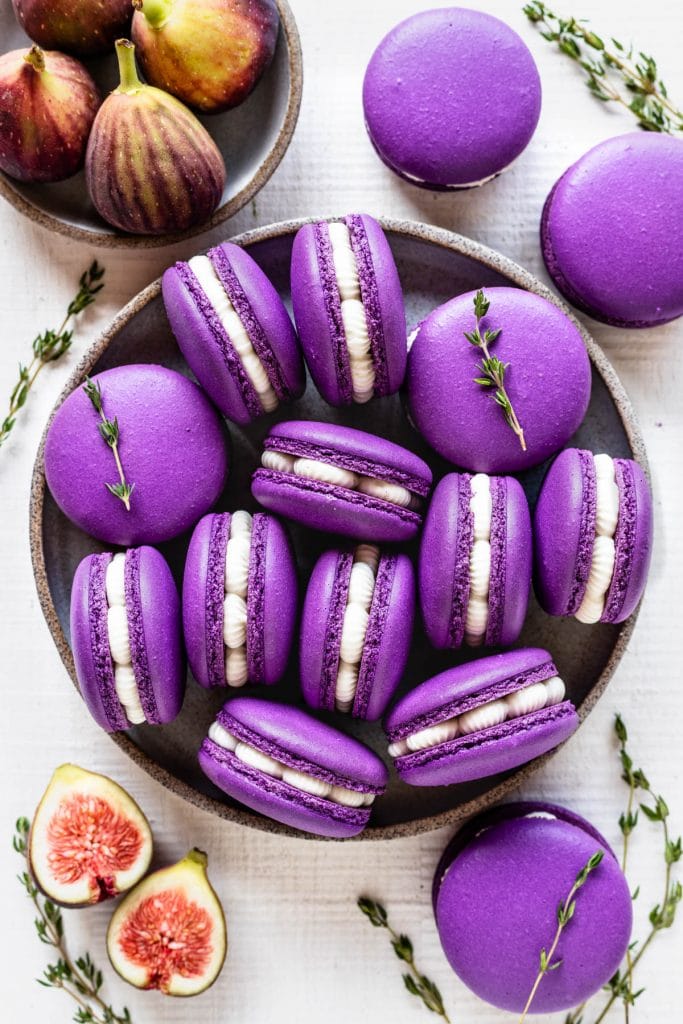
Also make sure to watch the video on this page or on my YouTube channel, which shows you exactly how to make these Fig Macarons.
This post may contain affiliate links. I earn a commission from qualified purchases. Please read our Privacy policy here.
For today’s recipe, I will be touching on a topic which is a new experiment I’ve been playing around with.
After seeing Nicole from Bake Toujours using egg white powder on her macaron shells, I decided to try doing the same to mine.
Nicole is a professional chef, a talented macaron baker and YouTuber, definitely check out her channel if you haven’t already.
But if you are a macaron baker, chances are you know about Nicole and have already been following her, since she is such a helpful source of knowledge in our macaron community.
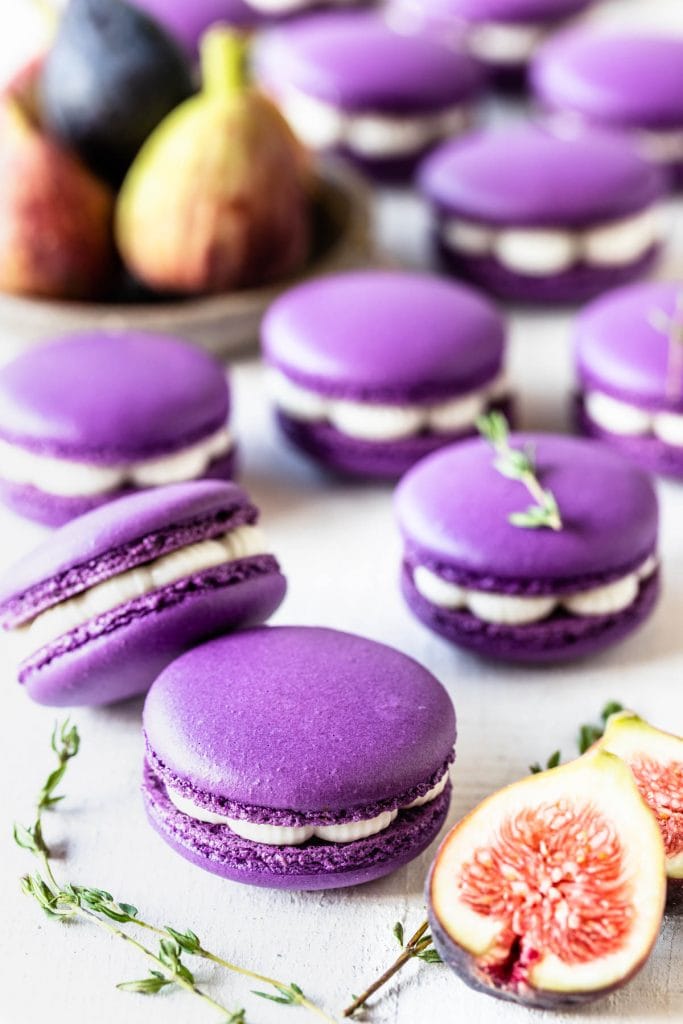
Anyway, egg white powder is not the same as meringue powder, so please don’t confuse them!
Egg white powder is made of only dried egg whites! While meringue powder has lots of ingredients, such as cornstarch, sugar, and other additives in it.
We are talking here about this product.
This is the brand I have been using. And I am loving to add egg white powder to my macaron shells.
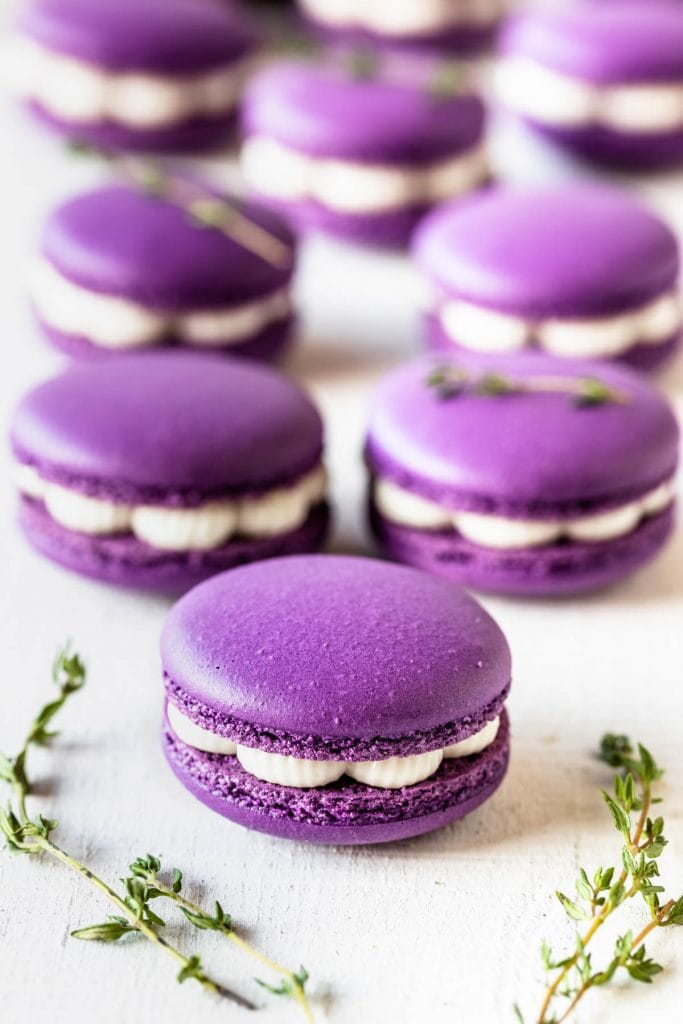
I am only adding 4 grams of egg white powder per 100 grams of egg whites.
And I’ve found that it’s best to add the egg white powder directly to the sugar, and whisk it with the granulated sugar before mixing the egg whites in. That’s because the dried egg whites will clump up if you add them directly to the actual egg whites.
When I whisk the dried egg whites with the granulated sugar, it dissolves better with the egg whites.
Some clumps may still form, but not to worry, they will eventually dissolve as you whip the meringue.
And you should do everything normally as you usually do when making the regular Swiss meringue macaron recipe, melt the sugar and egg whites (and dried egg whites) over a double boiler, then whip the meringue, and add the dry ingredients in.
No extra steps are needed besides whisking the egg white powder with the sugar before adding the egg whites in.
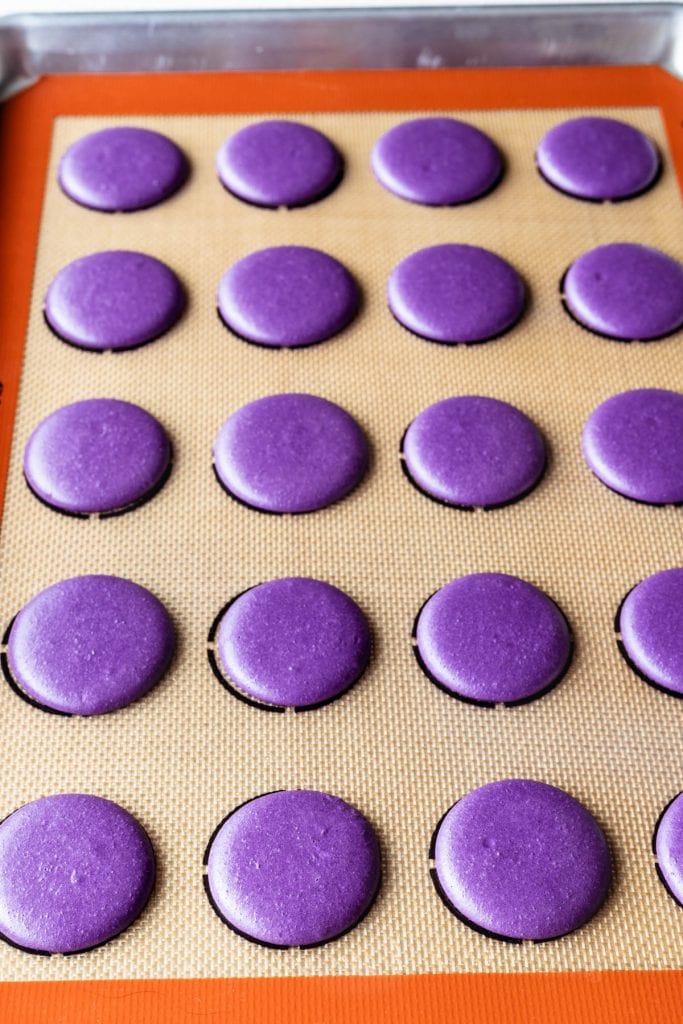
There are a couple of benefits of adding dried egg whites to the macaron shells. First one, they make the shells fuller. Maybe because they help out with the drying. Which brings me to the next benefit: they are a great addition to your shells if you live in a humid area, or if it’s a humid day out, or even, if you have plan on adding a lot of food coloring to your batter.
With these Fig Macarons, I added a lot of food coloring, as you can see on the video. I added a lot of purple, some blue and pink, in order to obtain that vibrant color.
The shells dried pretty quickly considering the amount of food coloring I had added.
Anyway, I am an adept of the egg white powder. I haven’t been adding to every batch I make, but I probably will be going forward.
And I recommend you experiment with it, see if it’s right for you. Then let me know in the comments or send me a dm to tell me what you think.
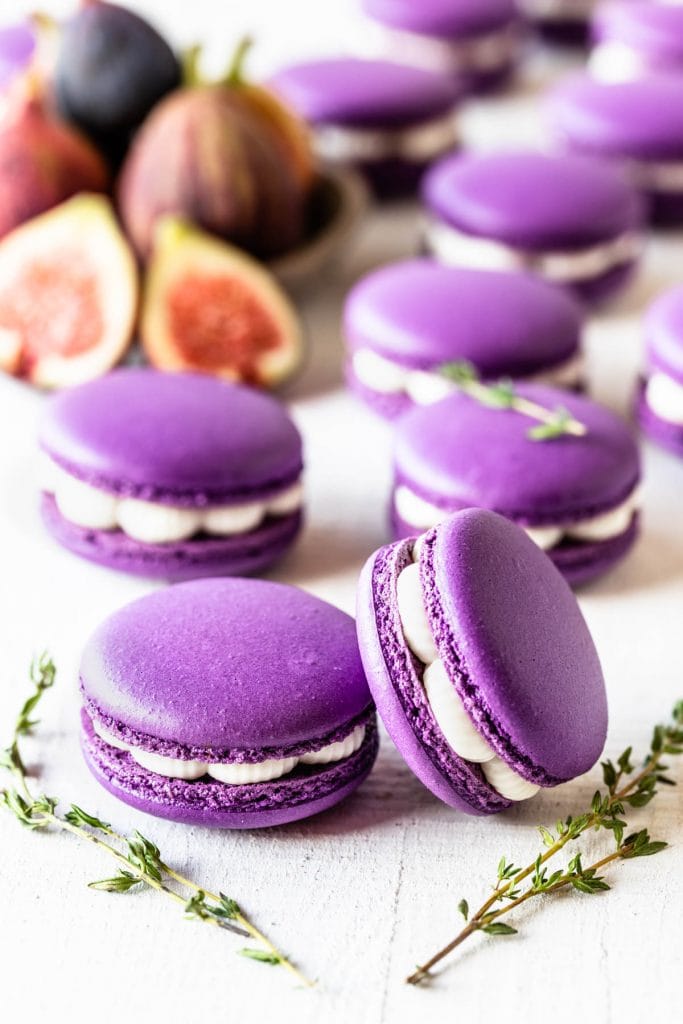
And like I’ve said, I added a lot of food coloring to these Fig Macarons, however, this is a recommendation for beginner macaron bakers: please refrain from using a lot of food coloring, and maybe refrain from using any at all.
When you add food coloring to the macaron batter, you are also adding moisture. And macaron batter with added moisture can be tricky to work with if you aren’t experienced.
The macarons may crack, or you may even end up over mixing the batter, in the attempt to keep incorporating the food coloring, if you continue to add it as you fold the batter.
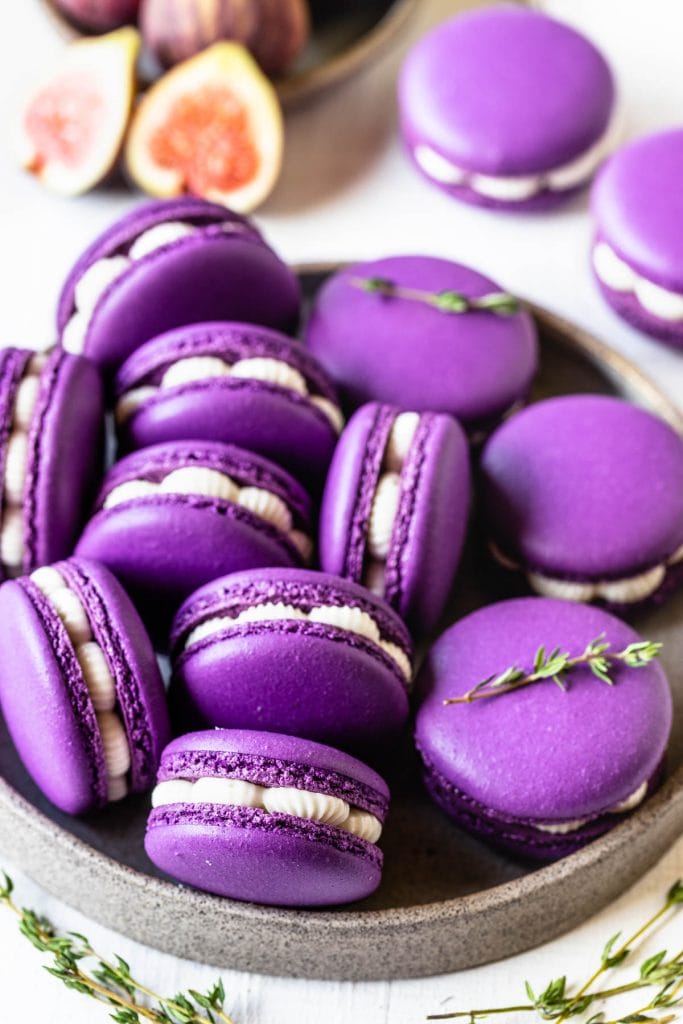
I hope you enjoyed today’s Fig Macarons.
For more macaron recipes, visit the Macarons category page, where I have so many different flavors and ideas.
Also, if you are learning how to make macarons, or finding any issues, please check out this page, I am calling it Macaron School, and I am placing all of my resources there, in order to help you out, my fellow macaron baker!
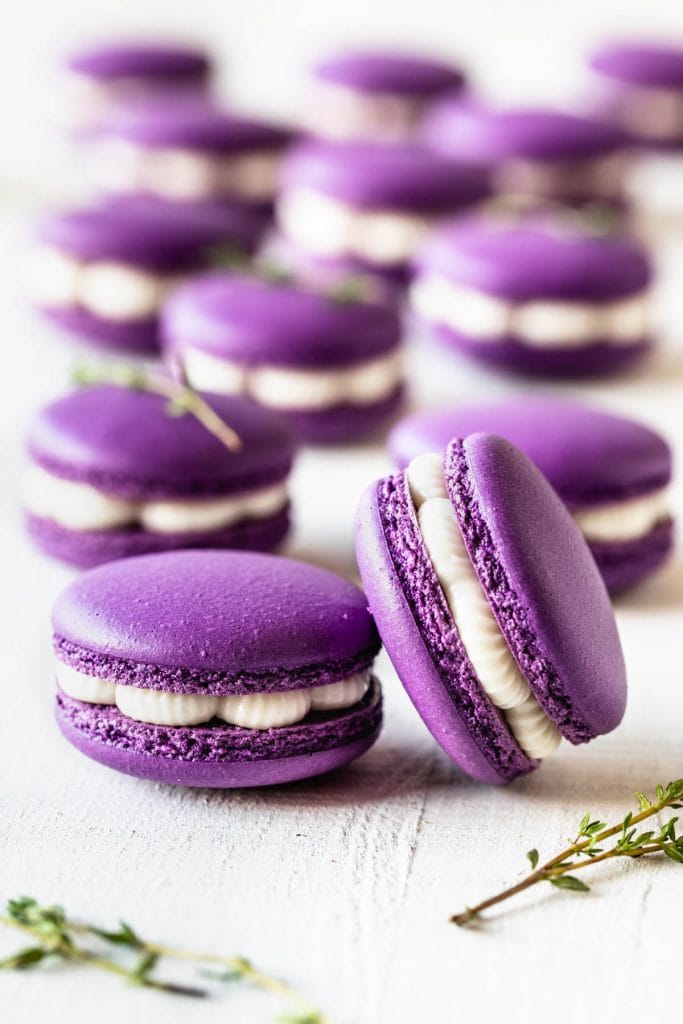
And here are some more recipes you may enjoy:
- Red Velvet Macarons
- Mint Chocolate Macarons
- Honey Macarons
- Earl Grey Macarons
- Blood Orange Macarons
- Passionfruit Macarons
- Apple Macarons
- Chocolate Strawberry Macarons
- Orange Macarons
- Blueberry Jam Macarons
- Pomegranate Macarons
- Raspberry Macarons
- Blackberry Macarons
Between many others! This is just a tiny list of macaron flavors.
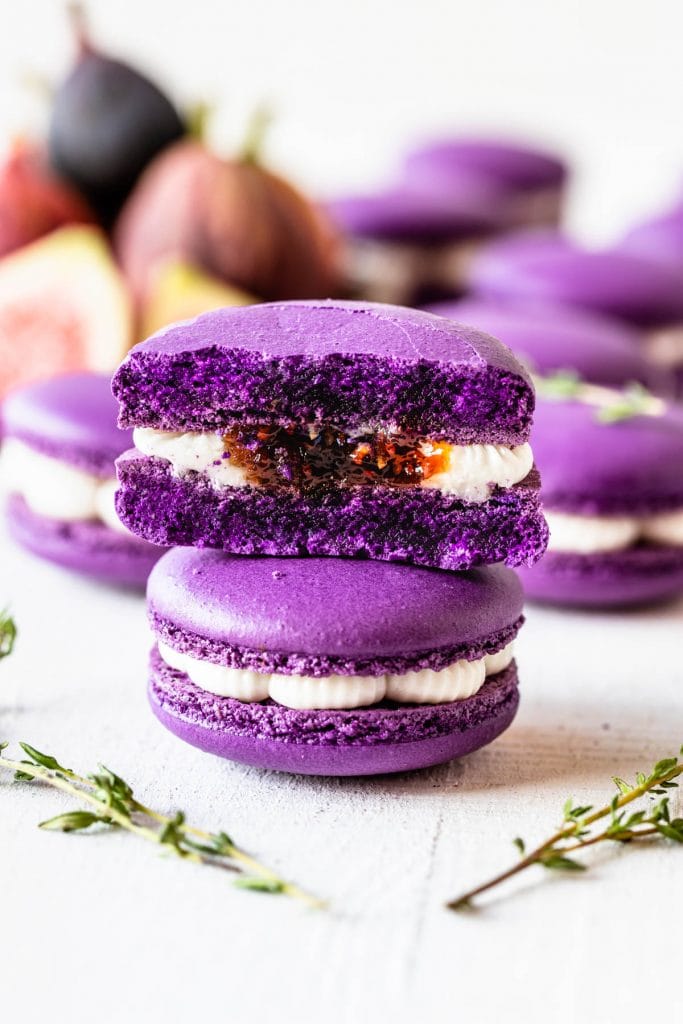
If you make this or any of my recipes, please consider leaving a comment, or a star rating below, which is very helpful to me and the other readers. Also tag me on instagram, I love seeing your creations!
Thank you so much for reading!
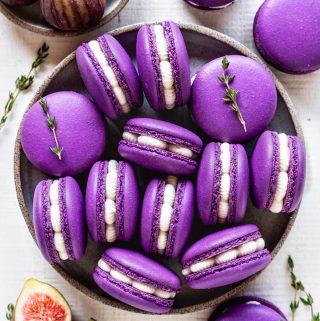
Fig Macarons
Ingredients
Macaron Shells
- 4 grams egg white powder optional, read notes
- 100 grams granulated sugar 3.5 oz
- 100 grams egg whites 3.5 oz
- 105 grams almond flour 3.7 oz
- 105 grams powdered sugar 3.7 oz
- Food coloring I used purple, blue, and pink
Fig Jam
- 1/2 lb fresh figs stemmed and halved
- 1/4 cup granulated sugar
- 2 tbsp honey
- 2 tbsp lemon juice 1 lemon
Honey Cream Cheese Frosting
- 2 tbsp unsalted butter softened 28 grams, 1 oz
- 1/4 cup cream cheese softened 56 grams, 2 oz
- 2 tbsp honey 30 ml
- 1 1/2 cups powdered sugar 187 grams, 6.5 oz
Instructions
Macaron Shells
- Before you start, get all of the ingredients ready. Prepare a large piping bag, fitted with a large round tip, I use a 1/2” diameter tip. Set aside.
- Line two baking sheets with parchment paper or silicone mat.
- Measure out all of the ingredients.
- Sift the powdered sugar and almond flour together. Set it aside.
- Whisk the sugar and the egg white powder (if using) in a bowl, and place it over a pan with barely simmering water. Add the egg whites to the sugar and whisk the mixture until frothy and the sugar is completely melted. It will take a couple of minutes. You can test by touching the mixture between your fingers, and if you feel any sugar granules just keep whisking the mixture over the water bath.
- Make sure the bottom of the bowl isn’t touching the simmering water because you don’t want the whites to cook.
- Also, don’t overheat the sugar syrup, this may cause issues down the line, such as wrinkly macarons.
- Transfer the syrup to the bowl of a stand mixer.
- With the whisk attachment, start whisking mixture on low for about 30 seconds, then gradually start increasing speed to medium. Whisk on medium for one to two minutes, until the mixture is white and starting to become fluffy. Raise the speed to high, or medium-high and whisk for a few minutes until stiff peaks are formed. Best way to check this is to keep your eye on the whites. Once they get glossy and you start seeing streaks formed by the whisk, it might be time to stop.
- Whisk until stiff peaks have formed. When you pull your whip up, the peak should be stiff and shooting straight up, with possibly a slight bend at the top, but not bending down to the side.
- Pour the sifted powdered sugar and almond flour into the stiff meringue.
- Start folding gently forming a letter J with a spatula.
- Add the food coloring at this point, if using. I’ve added purple, blue, and pink food coloring.
- How to know when to stop folding the batter: It’s time to stop folding when the batter is glossy and has a thick and flowing consistency. There are several ways to test this.
- First, pick up some batter with the spatula and try to draw a figure 8 with the batter that is dripping off the spatula. If you can form several 8 figures without the batter breaking up, that’s one indication that it might be ready.
- There’s another test you can do. I call it the Teaspoon test.
- Grab a teaspoon of batter and spoon onto the parchment paper or silicon mat. Wait a minute to see how it behaves.
- If the batter stays stiff, forming a point and doesn’t spread out, fold a little bit more, about 3 folds.
- Test again.
- Once the batter spreads out a bit and starts to look glossy and smooth on top, on the parchment paper, it’s ready.
- You don’t want your batter to be too runny either. So be careful not to overmix. It’s always best to undermix and test several times until the proper consistency has been achieved.
- When you hold the spatula with batter on top of the bowl and the batter falls off the spatula slowly but effortlessly the batter is ready. The batter will keep flowing off the spatula non-stop, but not too quickly.
- Transfer the batter to the piping bag.
- Place the piping bag directly 90 degrees over the center of each macaron template. Apply gentle pressure and carefully pipe for about 3 seconds, and then quickly pull the bag up twisting slightly.
- Once you’ve piped as many circles as you could, bang the trays against the counter a few times each. This will release air bubbles that are in the batter and prevent your macaron shells from cracking.
- Use a toothpick to pop any air bubbles in the surface of the shells.
- Let the trays sit for a while so the shells will dry out a little bit. I usually leave about 20-40 minutes, depending on how humid the day is. You’ll know they’re ready when you gently touch the surface of a macaron and it seems dry.
- Pre-heat the oven to 300ºF.
- Bake one tray at a time.
- Bake for 5 minutes, rotate tray.
- Bake for 5 more minutes. Rotate again.
- I bake each tray for about 15 to 20 minutes.
- When baked, the macarons will have a deeper color and formed feet. If you try to move a macaron, it shouldn’t feel jiggly. If the macaron is still jiggly, keep baking.
- Remove from the oven and bake the other tray.
- Let the macarons cool down before proceeding with the filling.
Fig Jam
- Place the figs, sugar, honey, and lemon juice in a small saucepan with a heavy bottom.
- Bring to a boil over medium heat. Reduce the heat and continue to cook the figs, while stirring occasionally, for about 40 minutes.
- By then, the figs should have dissolved, and the jam will be very thick.
- Keep an eye during cooking, if the mixture gets too dry and starts to stick to the bottom of the pan, add a splash of water to the pan.
- Remove from the heat once the jam is thick.
- You can wait for it to cool slightly and then process it in a small food processor, to make it easier to fill the macarons without huge chunks of figs in there.
- Place the jam in the fridge until ready to fill the macarons.
Honey Cream Cheese Frosting
- Add the butter and cream cheese to a bowl, and cream with a mixer for about 2 minutes, until fluffy.
- Add the honey, and mix to combine.
- Add the powdered sugar and mix on low until incorporated, then raise the speed to medium-high until creamy.
- If the frosting is too runny, add more powdered sugar to thicken it. And if the buttercream is too stiff, add a teaspoon or so of water or milk to thin it out.
To assemble
- Place the Honey Cream Cheese Frosting in a piping bag fitted with the tip of choice. I used a small star tip.
- Then pipe a ring of frosting around the edges of each bottom shell. I chose to pipe little dots to form a ring.
- Next, fill the middle of each bottom shell with a bit of jam. Top with another shell.
Storage
- Store the macarons in the fridge for up to 6 days.
- You can freeze these macarons for up to 1 month, as long as the jam isn’t too runny, otherwise the macarons will end up being soggy.



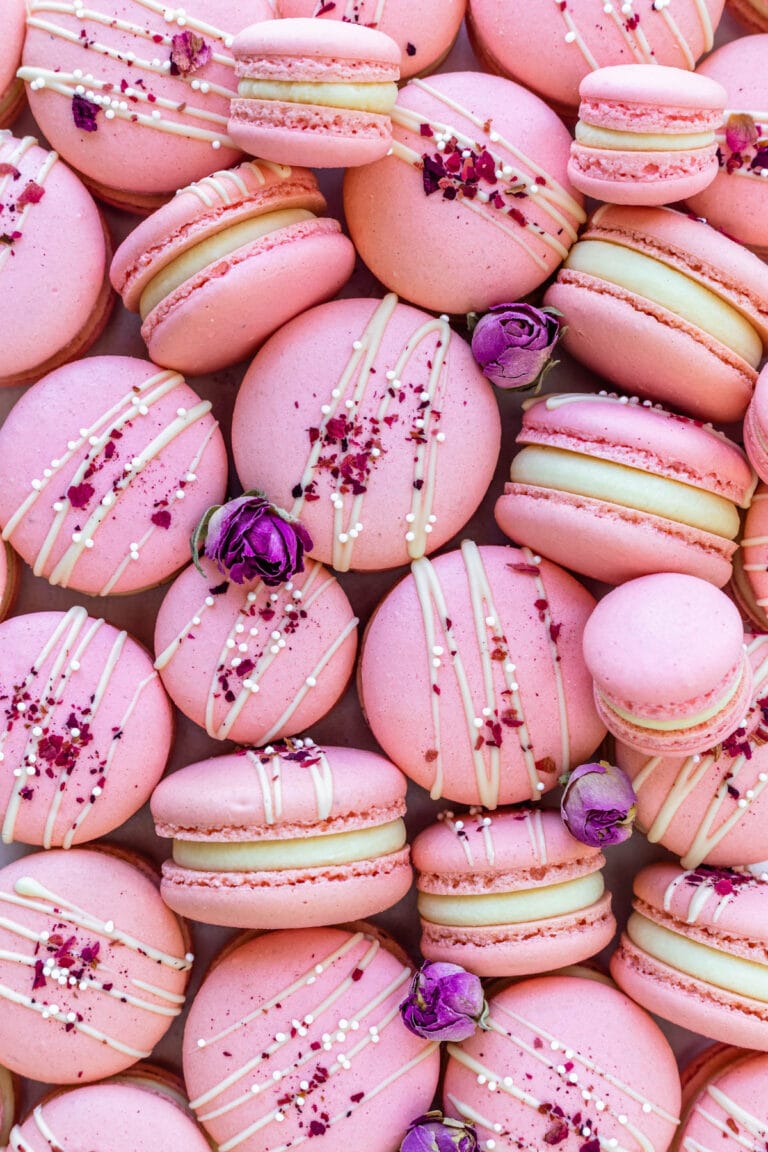
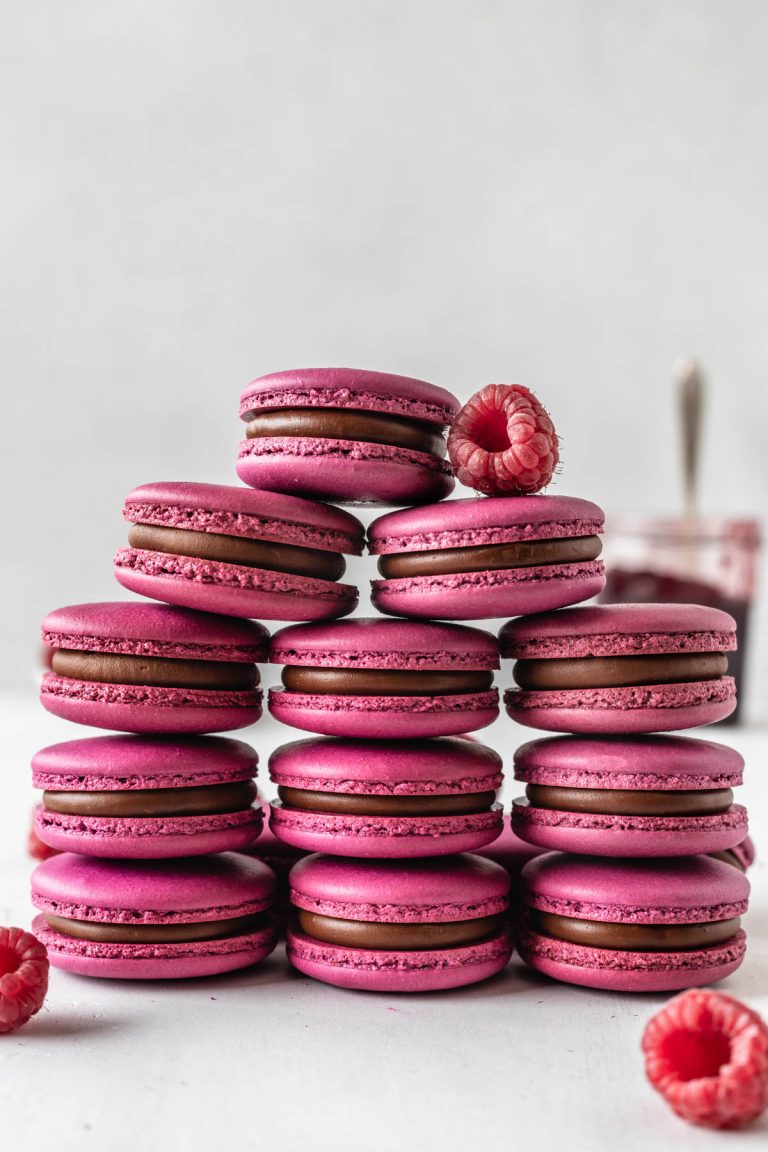
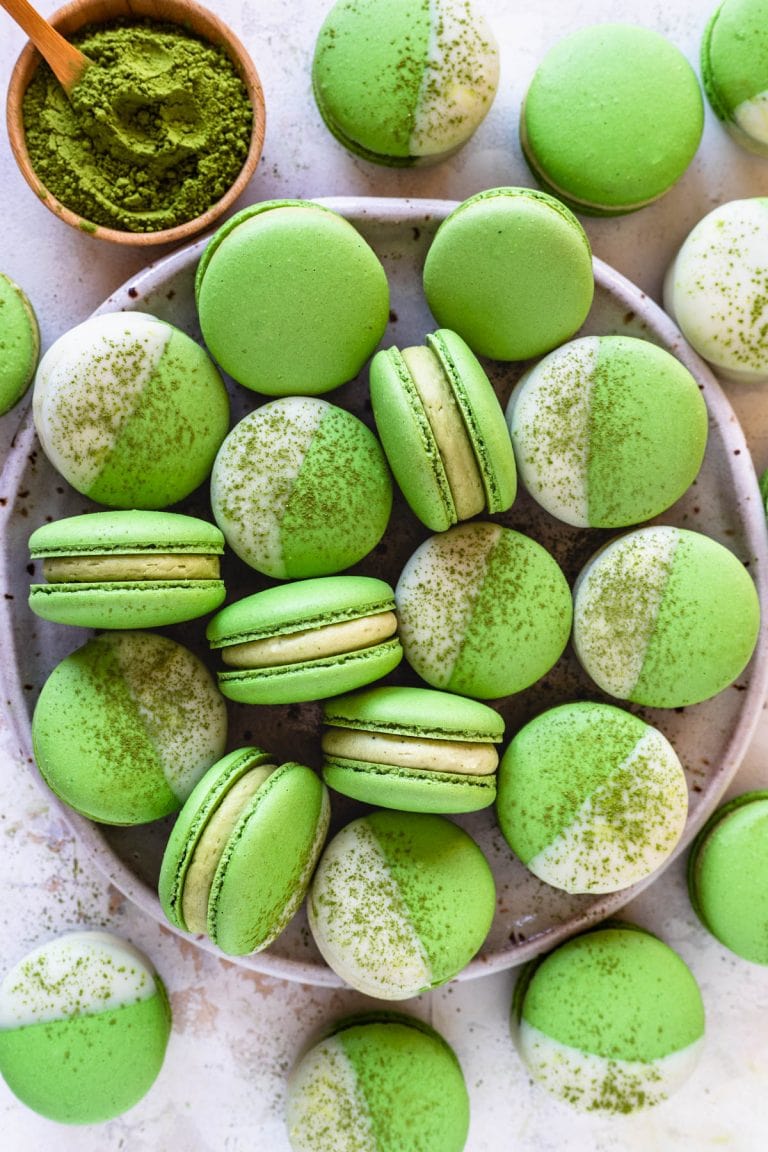
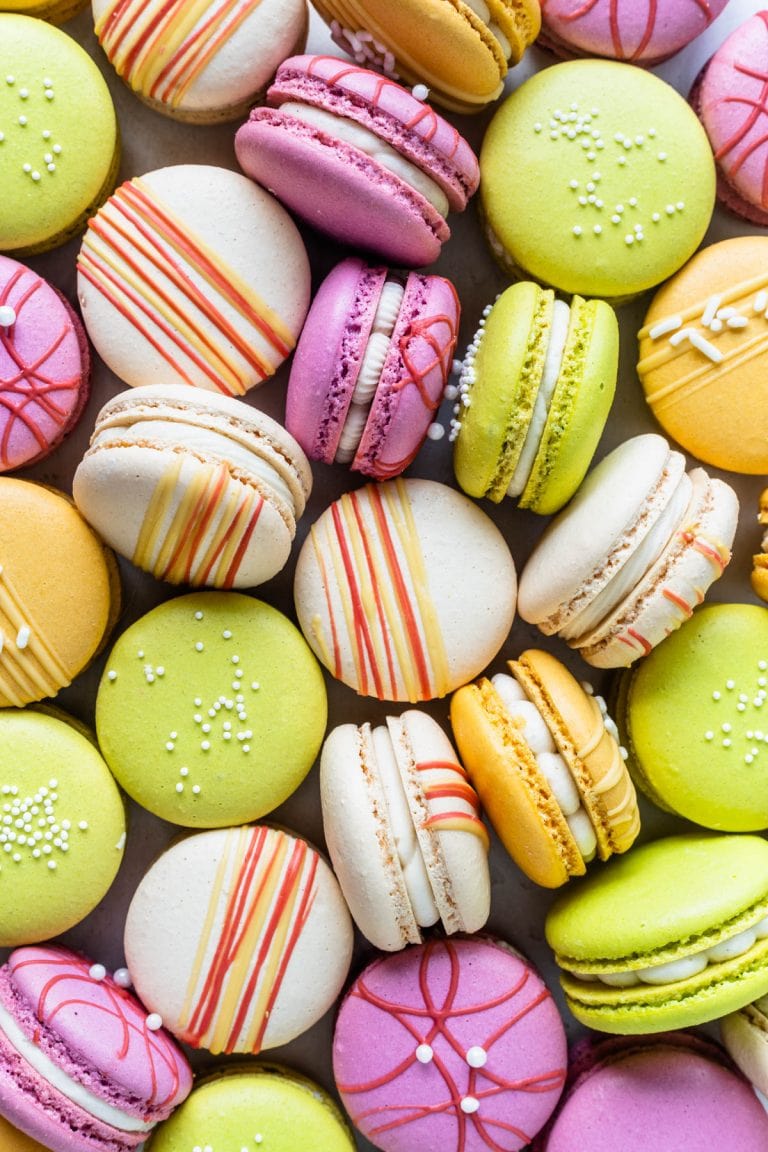
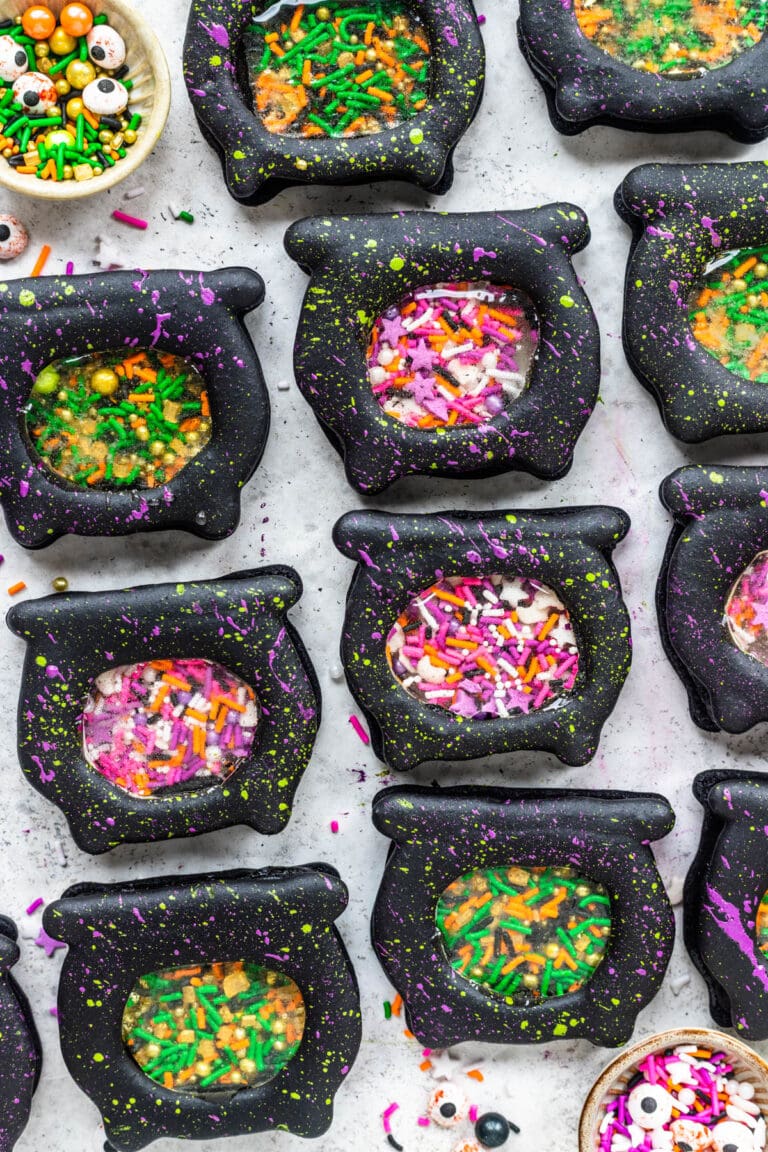
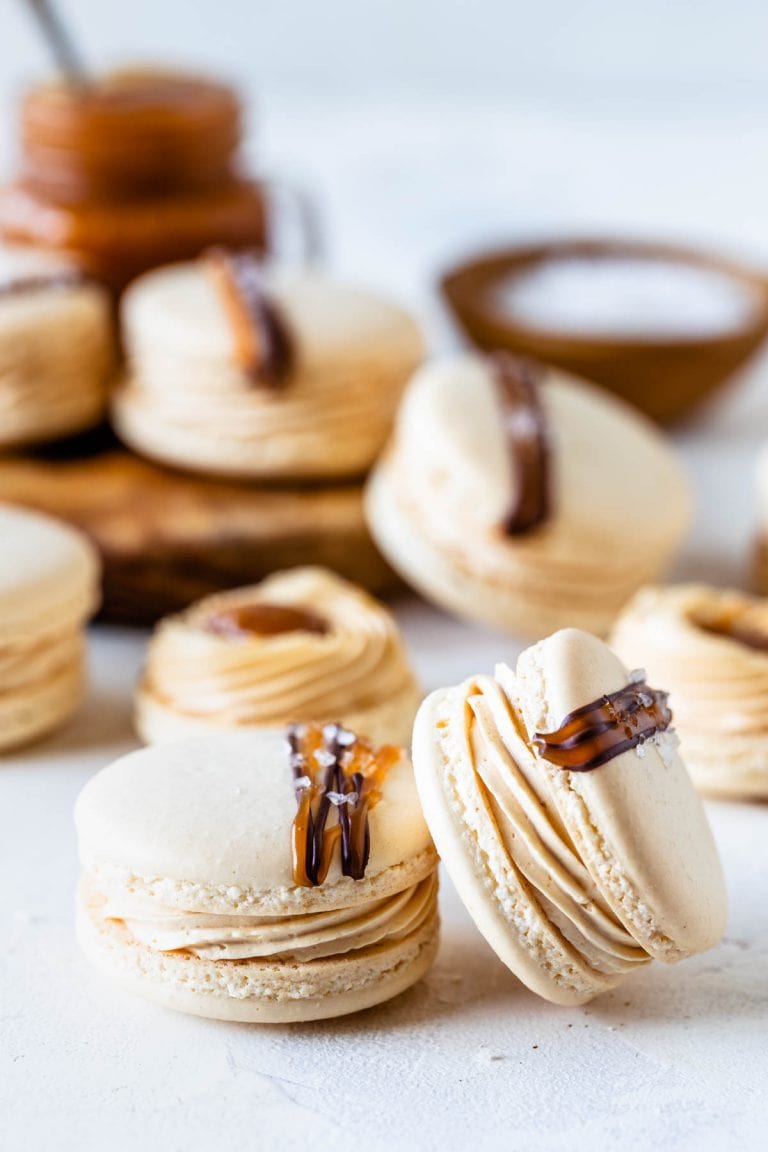
Ficaram uma delícia, que cor linda!!!!!!
Obrigada pai 🙂
Any idea if the egg white powder can be added to the macarons using the French technique?
yes it can! Add it at the beginning of whipping the whites, whisk for a while to try and incorporate it. It will be lumpy, that’s ok, it will incorporate later.
Turned out great but when I baked them the edges of the cookie turned brown. How do I fix this?
experiment with a lower temperature, dont use dark baking sheets, make sure you have an oven thermometer, cover the macarons with foil after they are halfway done baking… lots of options and things you can experiment with to improve that.
for the food colouring, was it purple, pink and blue all together? o were you just saying purple and if one doesn’t have purple, to add pink and blue?
I used purple, also blue and also pink.
I see some your recipes use cornstarch and some using egg white powder for fuller macarons. What is the difference in result . i would like to make macaron cake but i’m hesitating to buy egg white powder . Would cornstarch work ?
Thank you in advance
They dont do precisely the same thing. The cornstarch prevents the protein bonds from tightening too much, and the egg white powder adds more protein to the meringue, which would work as an added “layer of strength” for the meringue. Anyway, I feel like cornstarch sometimes makes my shells too soft depending on the weather.
Specially for macaron cake, I wouldn’t add cornstarch. But that’s my personal opinion, you can definitely experiment with it and see if it turns out ok for you. But you could also just leave both out, I’ve made macarons successfully for years without adding any of those things 🙂 good luck!!!
Hi. I’m wondering if the egg white powder is similar to the egg white protein powder? Not sure if there’s any difference. What about meringue powder?
Thank you
The ingredients should read: egg whites. Only egg whites. It shouldn’t have anything else added.
Meringue powder is not the same, because it has added cornstarch, sugar, and additives, but some people use it with success.
If I were to use just egg whites, how much should I use? I am anxious for to make these-yours are BEAUTIFUL!
the same amount, nothing changes 🙂
Thank you so much! I have been struggling with hollow shells. It’s been very frustrating. These turned out nice and full! The only thing is that the feet weren’t perfect (a little too ruffly). Any suggestions? I followed your recipe exactly. Thank you!
if the feet were ruffly it can be from over whipping the meringue, over mixing the batter or high oven temperature. I have more info here on these posts:
https://www.piesandtacos.commacaron-troubleshooting/
https://www.piesandtacos.comhollow-macarons/
Thank you! I watched many of your videos and lowered my oven temperature and it worked! The feet look great AND no hollows! Thanks again!
If my recipe has 140 grams of egg whites, how many gram of egg white powder do I need? Thank you
quantity of egg white powder depends on various things such as weather, etc. I use about 4 grams for 100 grams, but if the weather is dry, I use less or dont use it at all.
Can you use dried egg powder in Italian meringue for macarons? If so, when can I add them?
I dont know, I dont make Italian meringue sorry!
Could I use oat flour instead of almond flour?
I havent tried with oat flour.